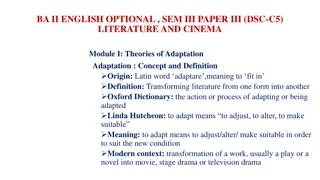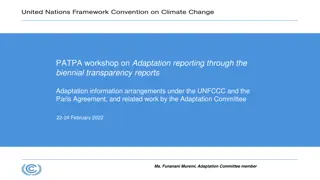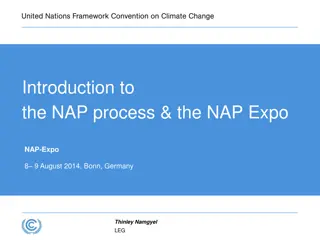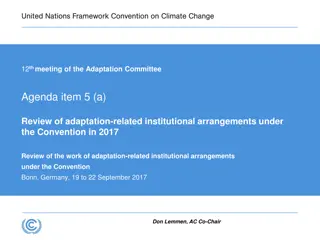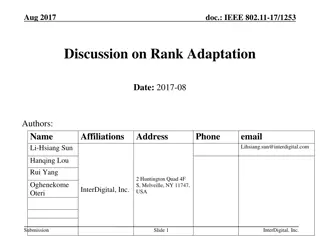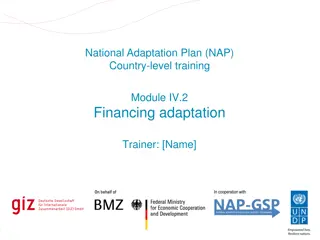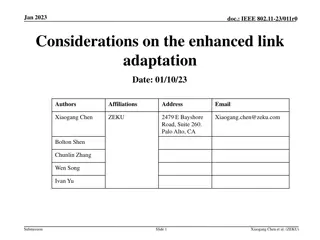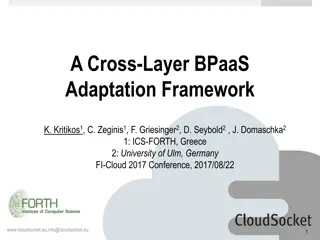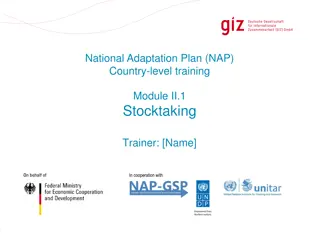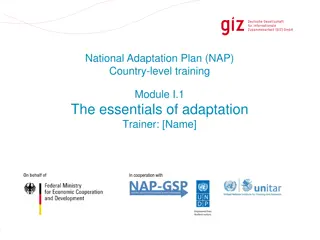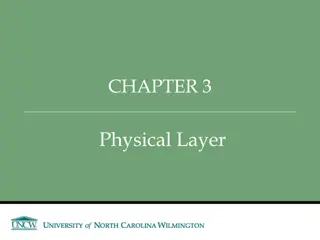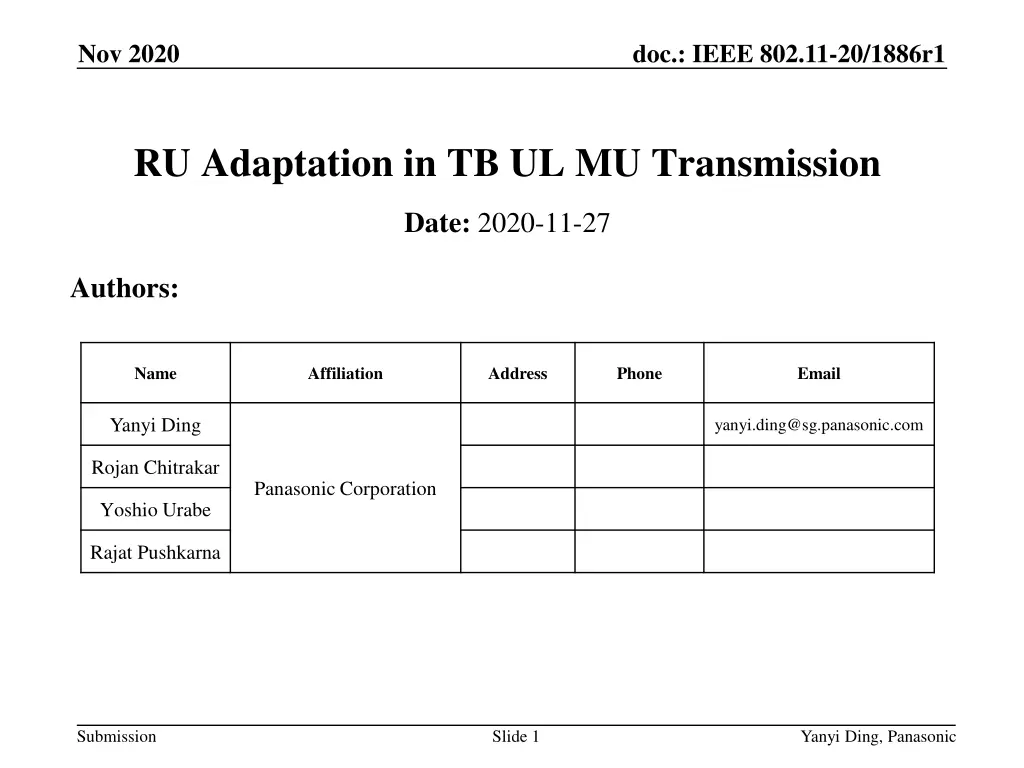
IEEE 802.11-20/1886r1 RU Adaptation in TB UL MU Transmission
Explore how RU adaptation optimizes UL MU transmission in IEEE 802.11-20/1886r1, proposing efficient medium usage to enhance system throughput. See the innovative signaling options and the AP's role in enabling adaptive RU/MRU allocation. Learn how STAs can adapt RU/MRU dynamically based on medium conditions for improved transmission efficiency.
Download Presentation

Please find below an Image/Link to download the presentation.
The content on the website is provided AS IS for your information and personal use only. It may not be sold, licensed, or shared on other websites without obtaining consent from the author. If you encounter any issues during the download, it is possible that the publisher has removed the file from their server.
You are allowed to download the files provided on this website for personal or commercial use, subject to the condition that they are used lawfully. All files are the property of their respective owners.
The content on the website is provided AS IS for your information and personal use only. It may not be sold, licensed, or shared on other websites without obtaining consent from the author.
E N D
Presentation Transcript
Nov 2020 doc.: IEEE 802.11-20/1886r1 RU Adaptation in TB UL MU Transmission Date: 2020-11-27 Authors: Name Affiliation Address Phone Email Yanyi Ding yanyi.ding@sg.panasonic.com Rojan Chitrakar Panasonic Corporation Yoshio Urabe Rajat Pushkarna Submission Slide 1 Yanyi Ding, Panasonic
Nov 2020 doc.: IEEE 802.11-20/1886r1 TB UL MU transmission problem In TB UL MU transmission, if CS requirement is indicated in the Trigger frame, ED is used to sense the medium by STAs on 20MHz subchannels overlapping the allocated RU/MRU. If any of the 20MHz subchannels is indicated as busy by ED-based CCA or virtual CS, the STA does not transmit TB PPDU at the allocated RU/MRU. Whole allocated large-size RU/MRU is wasted even if only a small number of 20MHz subchannels are detected as busy, which would degrade system throughput. frequency TB PPDU (STA1,RU484) busy 80MHz Basic trigger frame TB PPDU (STA2, RU242) TB PPDU (STA1,RU242) SIFS time Submission Yanyi Ding, Panasonic Slide 2
Nov 2020 doc.: IEEE 802.11-20/1886r1 RU Adaptation We propose an RU Adaptation procedure to avoid such waste. Not applicable to MU-MIMO transmission. In an RU adaptation procedure, a STA may adapt allocated RU/MRU according to the state of the medium. Example RU adaptation Primary 80MHz Secondary 80MHz 20MHz subchannels Allocated RU/MRU (RU484+RU996) busy RU adapation Adapted RU/MRU (RU996) Note: there may be many other possible options of adapted RU/MRU. Only the size of RU/MRU is adapted, other parameters for TB UL transmission remain unchanged. Submission Yanyi Ding, Panasonic Slide 3
Nov 2020 doc.: IEEE 802.11-20/1886r1 Signaling options The AP may indicate whether RU adaptation procedure is enabled in the User Info field to the STA. There are several options for the EHT TB PPDU to indicate the adapted RU/MRU. Without explicit signaling Decoding may be performed based on blind decoding or signal detection of pre-EHT modulated fields in all 20MHz subchannels. Explicit signaling Adapted RU/MRU is explicitly signaled in U-SIG field of EHT TB PPDU Only small changes are needed. Submission Yanyi Ding, Panasonic Slide 4
Nov 2020 doc.: IEEE 802.11-20/1886r1 Conclusion Large-size RU/MRU may be wasted in UL MU transmission when CS is required. In this contribution, we propose the RU adaptation procedure to improve throughput of TB UL MU transmission with large-size RU/MRU. STA may adapt allocated RU/MRU according to the state of medium. Only small changes are needed for AP to decode the EHT TB PPDU transmitted on adapted RU/MRU. Submission Yanyi Ding, Panasonic Slide 5
Nov 2020 doc.: IEEE 802.11-20/1886r1 SP#1 Do you think that further investigation on RU adaptation concept for TB UL transmission should be considered? Note: not for SFD Y/N/A: Submission Yanyi Ding, Panasonic Slide 6
Nov 2020 doc.: IEEE 802.11-20/1886r1 Annex: details about RU Adaptation Submission Yanyi Ding, Panasonic Slide 7
Nov 2020 doc.: IEEE 802.11-20/1886r1 RU Adaptation Define Associated RU/MRU for each large-size RU/MRU Associated RU/MRU is a set of possible options of adapted RU/MRU where the STA shall choose from when a large-size RU/MRU is allocated. Some restrictions may be enforced, for example, set a threshold for the size. Example (the size of associated RU/MRU shall not be smaller than 50% of the size of allocated RU/MRU) BW (MHz) RU/MRU Larger Than 242 Tones Associated RU/MRU 40, 80, 160/80+80, 320/160+160 RU484 RU484, RU242 (two options) 80, 160/80+80, 320/160+160 RU242+RU484 RU242+RU484, RU484 80, 160/80+80, 320/160+160 RU996 RU996, RU242+RU484 (4 options), RU484 (2 options) 160/80+80, 320/160+160 RU484+RU996 RU484+RU996, RU996, RU484+RU242 (4 options) ... * When part of the allocated RU/MRU which is detected as idle does not match or cover any of its associated RU/MRU, the allocated RU/MRU is not adapted. Submission Yanyi Ding, Panasonic Slide 8


